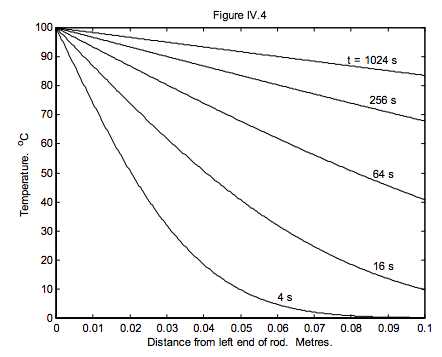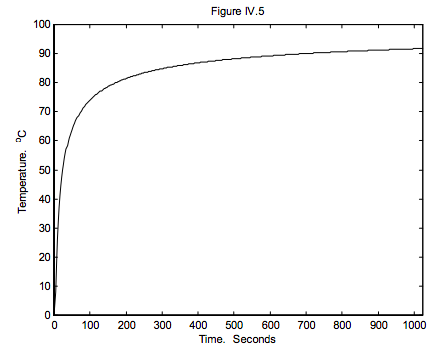4.5: A Solution of the Heat Conduction Equation
- Page ID
- 7232
\( \newcommand{\vecs}[1]{\overset { \scriptstyle \rightharpoonup} {\mathbf{#1}} } \)
\( \newcommand{\vecd}[1]{\overset{-\!-\!\rightharpoonup}{\vphantom{a}\smash {#1}}} \)
\( \newcommand{\id}{\mathrm{id}}\) \( \newcommand{\Span}{\mathrm{span}}\)
( \newcommand{\kernel}{\mathrm{null}\,}\) \( \newcommand{\range}{\mathrm{range}\,}\)
\( \newcommand{\RealPart}{\mathrm{Re}}\) \( \newcommand{\ImaginaryPart}{\mathrm{Im}}\)
\( \newcommand{\Argument}{\mathrm{Arg}}\) \( \newcommand{\norm}[1]{\| #1 \|}\)
\( \newcommand{\inner}[2]{\langle #1, #2 \rangle}\)
\( \newcommand{\Span}{\mathrm{span}}\)
\( \newcommand{\id}{\mathrm{id}}\)
\( \newcommand{\Span}{\mathrm{span}}\)
\( \newcommand{\kernel}{\mathrm{null}\,}\)
\( \newcommand{\range}{\mathrm{range}\,}\)
\( \newcommand{\RealPart}{\mathrm{Re}}\)
\( \newcommand{\ImaginaryPart}{\mathrm{Im}}\)
\( \newcommand{\Argument}{\mathrm{Arg}}\)
\( \newcommand{\norm}[1]{\| #1 \|}\)
\( \newcommand{\inner}[2]{\langle #1, #2 \rangle}\)
\( \newcommand{\Span}{\mathrm{span}}\) \( \newcommand{\AA}{\unicode[.8,0]{x212B}}\)
\( \newcommand{\vectorA}[1]{\vec{#1}} % arrow\)
\( \newcommand{\vectorAt}[1]{\vec{\text{#1}}} % arrow\)
\( \newcommand{\vectorB}[1]{\overset { \scriptstyle \rightharpoonup} {\mathbf{#1}} } \)
\( \newcommand{\vectorC}[1]{\textbf{#1}} \)
\( \newcommand{\vectorD}[1]{\overrightarrow{#1}} \)
\( \newcommand{\vectorDt}[1]{\overrightarrow{\text{#1}}} \)
\( \newcommand{\vectE}[1]{\overset{-\!-\!\rightharpoonup}{\vphantom{a}\smash{\mathbf {#1}}}} \)
\( \newcommand{\vecs}[1]{\overset { \scriptstyle \rightharpoonup} {\mathbf{#1}} } \)
\( \newcommand{\vecd}[1]{\overset{-\!-\!\rightharpoonup}{\vphantom{a}\smash {#1}}} \)
\(\newcommand{\avec}{\mathbf a}\) \(\newcommand{\bvec}{\mathbf b}\) \(\newcommand{\cvec}{\mathbf c}\) \(\newcommand{\dvec}{\mathbf d}\) \(\newcommand{\dtil}{\widetilde{\mathbf d}}\) \(\newcommand{\evec}{\mathbf e}\) \(\newcommand{\fvec}{\mathbf f}\) \(\newcommand{\nvec}{\mathbf n}\) \(\newcommand{\pvec}{\mathbf p}\) \(\newcommand{\qvec}{\mathbf q}\) \(\newcommand{\svec}{\mathbf s}\) \(\newcommand{\tvec}{\mathbf t}\) \(\newcommand{\uvec}{\mathbf u}\) \(\newcommand{\vvec}{\mathbf v}\) \(\newcommand{\wvec}{\mathbf w}\) \(\newcommand{\xvec}{\mathbf x}\) \(\newcommand{\yvec}{\mathbf y}\) \(\newcommand{\zvec}{\mathbf z}\) \(\newcommand{\rvec}{\mathbf r}\) \(\newcommand{\mvec}{\mathbf m}\) \(\newcommand{\zerovec}{\mathbf 0}\) \(\newcommand{\onevec}{\mathbf 1}\) \(\newcommand{\real}{\mathbb R}\) \(\newcommand{\twovec}[2]{\left[\begin{array}{r}#1 \\ #2 \end{array}\right]}\) \(\newcommand{\ctwovec}[2]{\left[\begin{array}{c}#1 \\ #2 \end{array}\right]}\) \(\newcommand{\threevec}[3]{\left[\begin{array}{r}#1 \\ #2 \\ #3 \end{array}\right]}\) \(\newcommand{\cthreevec}[3]{\left[\begin{array}{c}#1 \\ #2 \\ #3 \end{array}\right]}\) \(\newcommand{\fourvec}[4]{\left[\begin{array}{r}#1 \\ #2 \\ #3 \\ #4 \end{array}\right]}\) \(\newcommand{\cfourvec}[4]{\left[\begin{array}{c}#1 \\ #2 \\ #3 \\ #4 \end{array}\right]}\) \(\newcommand{\fivevec}[5]{\left[\begin{array}{r}#1 \\ #2 \\ #3 \\ #4 \\ #5 \\ \end{array}\right]}\) \(\newcommand{\cfivevec}[5]{\left[\begin{array}{c}#1 \\ #2 \\ #3 \\ #4 \\ #5 \\ \end{array}\right]}\) \(\newcommand{\mattwo}[4]{\left[\begin{array}{rr}#1 \amp #2 \\ #3 \amp #4 \\ \end{array}\right]}\) \(\newcommand{\laspan}[1]{\text{Span}\{#1\}}\) \(\newcommand{\bcal}{\cal B}\) \(\newcommand{\ccal}{\cal C}\) \(\newcommand{\scal}{\cal S}\) \(\newcommand{\wcal}{\cal W}\) \(\newcommand{\ecal}{\cal E}\) \(\newcommand{\coords}[2]{\left\{#1\right\}_{#2}}\) \(\newcommand{\gray}[1]{\color{gray}{#1}}\) \(\newcommand{\lgray}[1]{\color{lightgray}{#1}}\) \(\newcommand{\rank}{\operatorname{rank}}\) \(\newcommand{\row}{\text{Row}}\) \(\newcommand{\col}{\text{Col}}\) \(\renewcommand{\row}{\text{Row}}\) \(\newcommand{\nul}{\text{Nul}}\) \(\newcommand{\var}{\text{Var}}\) \(\newcommand{\corr}{\text{corr}}\) \(\newcommand{\len}[1]{\left|#1\right|}\) \(\newcommand{\bbar}{\overline{\bvec}}\) \(\newcommand{\bhat}{\widehat{\bvec}}\) \(\newcommand{\bperp}{\bvec^\perp}\) \(\newcommand{\xhat}{\widehat{\xvec}}\) \(\newcommand{\vhat}{\widehat{\vvec}}\) \(\newcommand{\uhat}{\widehat{\uvec}}\) \(\newcommand{\what}{\widehat{\wvec}}\) \(\newcommand{\Sighat}{\widehat{\Sigma}}\) \(\newcommand{\lt}{<}\) \(\newcommand{\gt}{>}\) \(\newcommand{\amp}{&}\) \(\definecolor{fillinmathshade}{gray}{0.9}\)Methods of solving the heat conduction equation are commonly given in courses on partial differential equations. Here we shall look at a simple one-dimensional example.
A long copper bar is initially at a uniform temperature of 0 oC. At time t = 0, the left hand end of it is heated to 100 oC. Draw graphs of temperature versus distance x from the hot end of the bar (up to x = 100 cm) at t = 4, 16, 64, 256 and 1024 seconds. Draw also a graph of temperature versus time at x = 5 cm, up to 1024 seconds. Assume no heat is lost from the sides of the bar.
Data for copper:
K = 400 W m−1 K−1
C = 395 J kg−1 K−1
ρ = 8900 kg m−3
whence
D = 1.137 × 10−4 m2 s−1
The equation to be solved is
\[ D \frac{\partial ^2 T}{\partial x^2} = \frac{\partial T}{\partial t}\]
From the form of this equation, it is obvious (once it has been pointed out!) that a solution could be found in which T(x, t) is solely a function of x2/t, or, for that matter, x/t1/2. Thus, let
\[ u = x/t^{1/2},\]
and you will see that equation 4.4.1 reduces to the second order total differential equation
\[ D \frac{d^2T}{du^2} = - \frac{u}{2} \frac{dT}{du}.\]
Let T' = dT/du, and it becomes even easier − a first order equation:
\[ D \frac{dT'}{du} = - \frac{1}{2} uT'.\]
Upon integration, we obtain
\[ \ln T' = - \frac{u^2}{4D} + \ln A,\]
where ln A is an integration constant, to be determined by the initial and boundary conditions. (What are the dimensions of A?)
That is,
\[ T' = A \text{exp} \left[ -u^2 /(4D) \right].\]
We have to integrate again, with respect to u:
\[ T = A \int \text{exp} \left[ - u^2/(4D) \right] du.\]
Now, T = 100 oC at x = 0 for any t > 0. That is, T = 100 for u = 0.
And T = 0 oC at t = 0 for any x > 0. That is, T = 0 for u = ∞.
Therefore
\[ 100 - 0 = A \int_{ \infty}^0 \text{exp} \left[ -u^2 /(4D) \right] du.\]
The integral is slightly difficult though well known. I'll just state the answer here; it is \( - \sqrt{ \pi D}\). From this, we find that the integration constant is
\[ A = -5284 \text{K m}^{-1} \text{s}^{1/2}.\]
We now have
\[ 100 - T (x,~t) = A \int_{xt^{-1/2}}^0 \text{exp} \left[ -u^2 /(4D) \right] du.\]
The error function erf(r) is defined by
\[ \text{erf} (r) = \frac{2}{ \sqrt{ \pi}} \int_0^r \text{exp} (-s^2)ds,\]
so that equation 4.4.10 can be written
\[ T (x,~t) = 100 + A \sqrt{ \pi D} \text{erf} \left( \frac{x}{ 2 \sqrt{Dt}} \right) = 100 \left[ 1 - \text{erf} \left( \frac{x}{2 \sqrt{Dt}} \right) \right].\]
This function is easy to plot provided that your computer will give you the erf function. The solutions are shown in figures IV.4 and 5.




